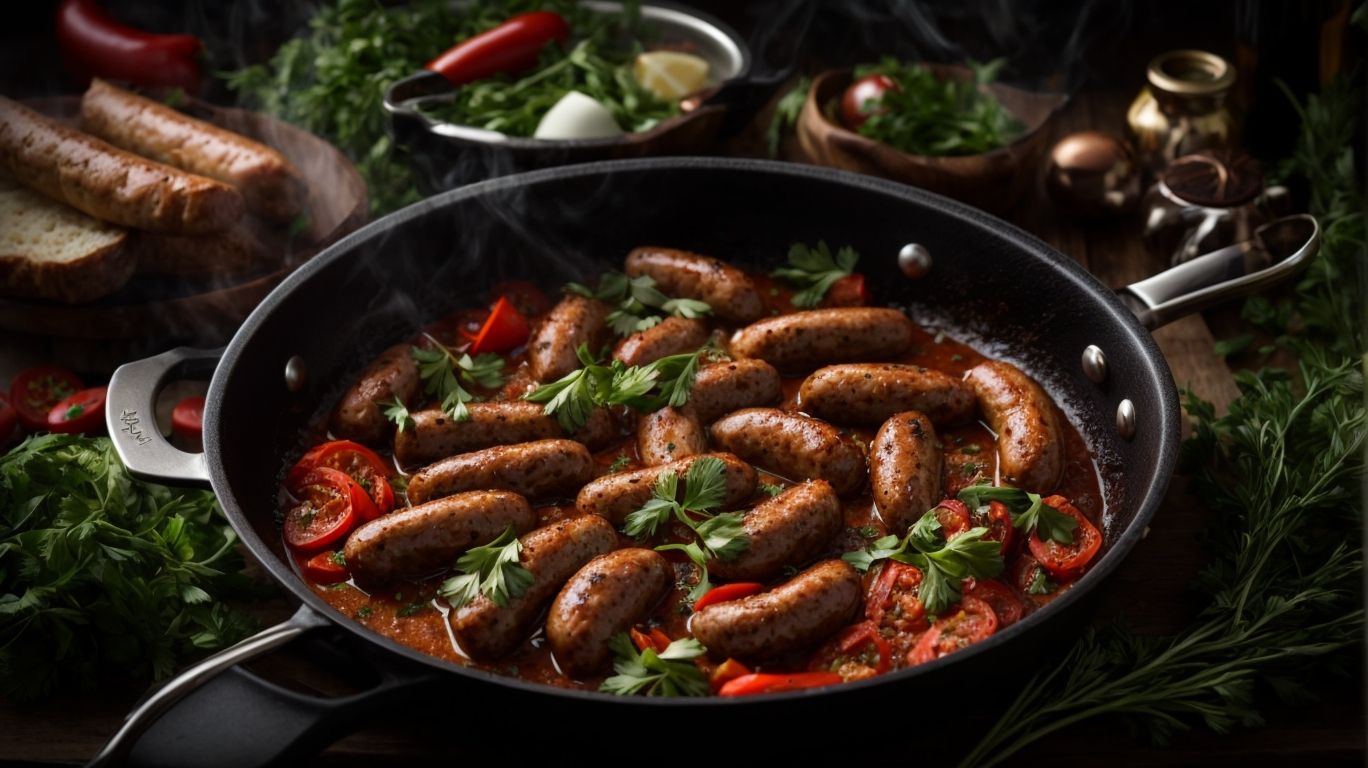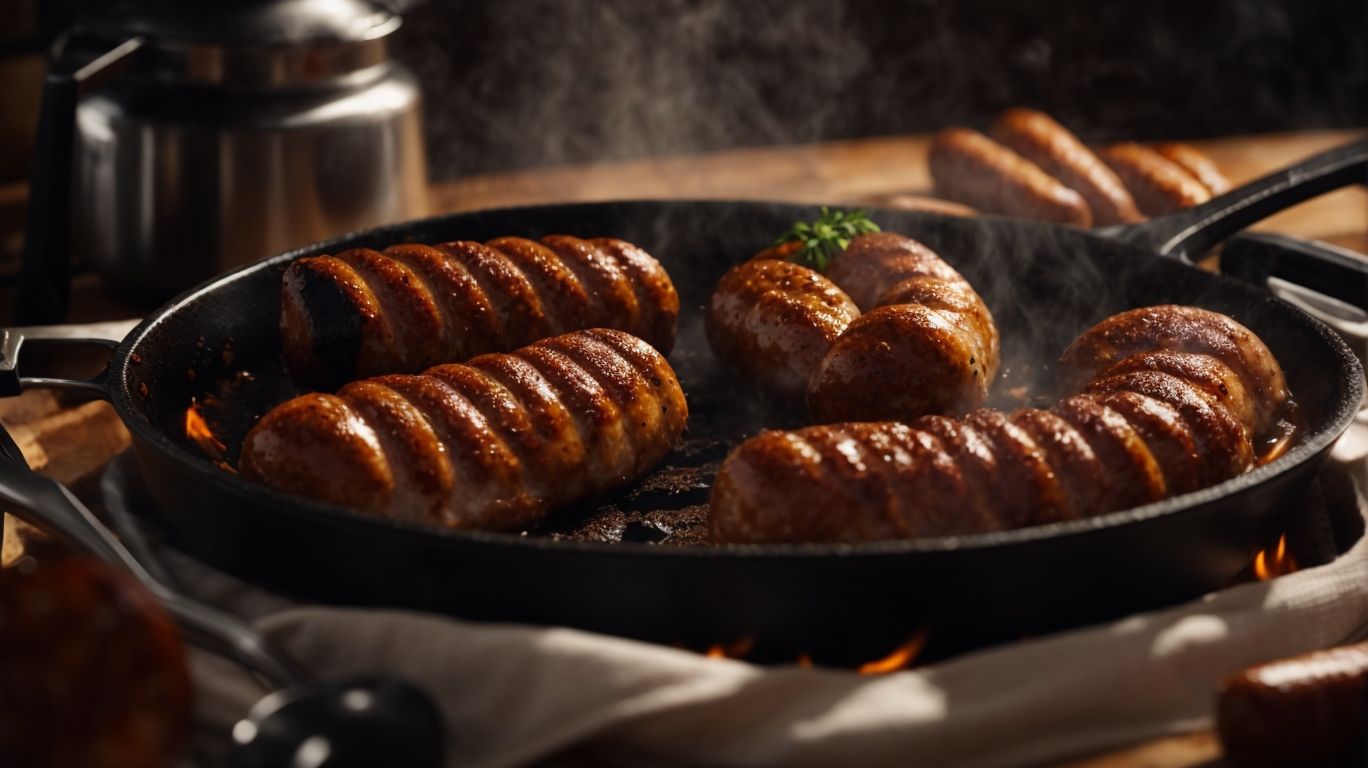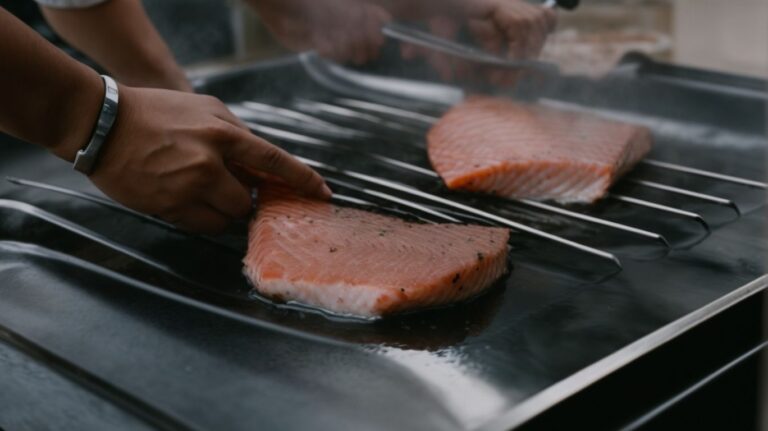How to Cook Italian Sausage?
Are you looking to spice up your meals with some delicious Italian sausage? Look no further!
Discover what sets Italian sausage apart from other sausages, the different types available, and how to choose the best one for your dishes.
Learn various cooking methods for Italian sausage, including grilling, pan-frying, and baking. We’ll also share some mouthwatering recipes to try.
Stay tuned for all the tips and tricks you need to master the art of cooking Italian sausage!
Key Takeaways:
What Makes Italian Sausage Different from Other Sausages?
Italian Sausage stands out from other sausages due to its unique blend of flavors and ingredients, such as fennel seeds and red pepper flakes, which give it a distinct taste profile.
Italian Sausage, originating from Italy, encapsulates the essence of traditional Italian cuisine with its robust flavors and rich history. The use of fennel seeds infuses a sweet, aromatic note, while the red pepper flakes add a gentle heat that complements the overall taste exceptionally. These signature ingredients are carefully blended with high-quality pork, garlic, and various herbs, creating a complex yet harmonious flavor profile that pairs perfectly with pasta dishes, pizzas, or simply enjoyed on its own.
Types of Italian Sausage

Credits: Poormet.Com – Terry Ramirez
Italian Sausage comes in various types, each offering a unique culinary experience that caters to different preferences and recipes.
Fresh Italian Sausage
Fresh Italian Sausage is a classic choice made with high-quality pork and seasoned with a blend of savory spices, ensuring a burst of flavor in every bite.
The pork used in crafting this sausage is often finely ground, creating a tender and succulent texture that blends perfectly with the signature seasonings. The seasoning mix typically includes garlic, fennel seeds, paprika, and sometimes red pepper flakes, giving the sausage its distinctive taste profile.
Whether grilled, sautéed, or baked, fresh Italian Sausage adds richness and depth to any dish. To retain its juiciness and full flavor, it’s advisable to cook the sausage slowly over medium heat, allowing the spices to infuse the meat while preventing it from drying out.
Cooked Italian Sausage
Cooked Italian Sausage offers convenience and versatility, whether grilled to perfection, sautéed on the stove, or baked in the oven, allowing for various cooking methods to suit different dishes.
Grilling Italian sausage brings out its smoky flavors, perfect for summer barbecues or adding a distinct char to pasta dishes.
On the stove, sautéing the sausage with onions and peppers creates a savory base for pasta sauces or flavorful sandwich fillings.
When baking Italian sausage, the oven’s even heat ensures a juicy interior and crispy exterior, ideal for casseroles or as a standalone main course.
Dry Italian Sausage
Dry Italian Sausage is a cured and aged delicacy known for its intense flavors, often featuring the distinct taste of fennel seeds and a rich, savory profile.
Handcrafted with a blend of finely ground pork, salt, pepper, and fennel seeds, Dry Italian Sausage undergoes a meticulous curing process, allowing the flavors to intensify as it ages. The fennel seeds, with their aromatic and slightly sweet notes, play a crucial role in defining the sausage’s signature taste. This infusion results in a robust and complex flavor profile that pairs exceptionally well with aged cheeses, crusty bread, olives, and a variety of wines, making it a versatile and beloved ingredient in Italian cuisine.
How to Choose the Best Italian Sausage?
Selecting the best Italian Sausage involves considering key factors such as the quality of ingredients, meat type used, and certifications that ensure authenticity and superior taste.
Check the Ingredients
When selecting Italian Sausage, scrutinize the ingredient list to ensure the presence of authentic flavors and high-quality components that contribute to a delicious culinary outcome.
Authentic Italian sausages are known for their rich blend of spices and seasonings that bring out the traditional flavors distinctive to this cuisine.
High-quality ingredients like premium cuts of meat, freshly ground spices, and natural casings play a crucial role in creating a sausage that is flavorful, juicy, and tender.
Look for certifications such as Protected Geographical Indication (PGI) or Denominazione di Origine Protetta (DOP) to ensure you are getting an authentic Italian product that meets stringent quality standards and reflects the essence of Italian culinary heritage.
Look for Quality Certification
Opt for Italian Sausage products that bear quality certifications, indicating the use of premium meats, minimal water content, and adherence to traditional recipes for an authentic and satisfying dining experience.
These certifications not only attest to the quality of the ingredients used but also guarantee the meticulous care taken during the production process. Italian Sausages that boast these certifications often contain high-grade meats that are finely ground and blended with select herbs and spices, creating a distinctive flavor profile.
The low moisture content in these sausages ensures a richer taste and firmer texture, highlighting the artisanal craftsmanship that goes into their creation. The adherence to traditional recipes further enhances the depth of flavors, providing a truly authentic gastronomic experience.
Consider the Type of Meat Used
Evaluate the type of meat used in Italian Sausage, with pork being a popular choice for its rich flavor and versatile application in creating delicious sausage links that complement various recipes.
In terms of selecting the meat for Italian Sausage, pork stands out for its distinctive taste and texture. The inherent richness of pork imparts a depth of flavor to the sausage links that adds a savory element to dishes. The fat content in pork creates juicy and succulent sausages, making them perfect for grilling, pan-frying, or adding to pasta dishes.
Pork also offers a good balance of lean meat and fat, allowing for a tender and moist sausage that is ideal for binding with spices and seasonings. This makes it a versatile option for incorporating different flavors, from spicy to savory, depending on the recipe. With sausage links, one can explore a range of culinary preparations, from hearty stews and casseroles to simple pasta dishes and sandwiches.
How to Cook Italian Sausage?

Credits: Poormet.Com – William Martin
Cooking Italian Sausage is a versatile process that can be accomplished through grilling, stove-top sautéing, oven baking, boiling, or slow cooking, allowing for diverse preparation methods to suit different recipes and preferences.
Grilling Italian Sausage
Grilling Italian Sausage over an open flame imparts a smoky flavor and caramelized exterior, enhancing the natural taste of the sausage with charred grill marks and juicy tenderness.
When preparing to grill Italian Sausage, it is essential to preheat your grill to medium-high heat, around 375-400°F (190-205°C), ensuring even cooking and the perfect sear on the sausages.
Before placing the sausages on the grill, brush them lightly with oil to prevent sticking and help achieve a beautifully crisp exterior.
Once on the grill, allow the sausages to cook for about 5-6 minutes per side, rotating occasionally to achieve those sought-after grill marks and ensure even cooking.
Pan-Frying Italian Sausage
Pan-frying Italian Sausage in a skillet creates a crispy exterior and locks in the savory juices, providing a burst of flavor with added seasonings like pepper and herbs for a delightful culinary experience.
In terms of achieving that perfect texture and taste for your Italian Sausage, mastering the art of pan-frying is key. To start, ensure you select a good quality skillet that distributes heat evenly. Cast iron or stainless steel pans work well for this. Before placing the sausages in the pan, make sure they are at room temperature to ensure even cooking. Seasoning the sausage with a generous amount of black pepper and fresh herbs enhances the flavors beautifully.
Baking Italian Sausage
Baking Italian Sausage in the oven yields a juicy and evenly cooked result, infusing the sausage with the aromatic notes of fennel seeds and other complementary spices for a flavorful dish.
To achieve the perfect balance of tenderness and flavor, preheat your oven to 375°F. This moderate temperature allows the sausage to cook through evenly without drying out, preserving its natural juices. Place the sausages on a baking sheet lined with parchment paper or aluminum foil to prevent sticking and facilitate easy cleanup.
Depending on the size and thickness of the sausages, they typically require around 20-25 minutes in the oven. Turning them halfway through the cooking time ensures uniform browning.
The addition of fennel seeds helps elevate the classic Italian flavors, providing a subtle sweetness and warmth. Experiment with sprinkling other spices like garlic powder, paprika, or red pepper flakes for a personalized touch. This seasoning blend not only enhances the taste but also creates a delightful aroma that fills your kitchen as the sausages bake.
Boiling Italian Sausage
Boiling Italian Sausage in water ensures a quick and efficient cooking process, with the sausages reaching the desired internal temperature within minutes, ready to be used in various recipes.
It is crucial to bring the water to a gentle simmer before adding the sausages to prevent them from bursting. Monitoring the cooking times is essential; typically, Italian sausages need about 15-20 minutes to cook thoroughly. To ensure safety, the internal temperature of the sausages should reach 160°F (71°C). Once boiled, the sausages can be sliced and added to pasta dishes, grilled for extra flavor, or used in sandwiches for a quick meal.
Cooking Italian Sausage in a Slow Cooker
Cooking Italian Sausage in a slow cooker allows for a hands-off approach to tenderizing the meat and infusing the flavors into hearty recipes, making it an ideal method for preparing delicious and effortless meals.
The convenience of a slow cooker is unbeatable; you can simply set it and forget it, allowing the flavors to develop over time without constant monitoring. The gentle, slow cooking process ensures that the sausages remain juicy and succulent, unlike faster cooking methods that can result in dryness. Not only does using a slow cooker enhance the depth of flavors in the dish, but it also saves you time and effort in the kitchen.
Recipes to Try with Italian Sausage
Explore a variety of delectable recipes featuring Italian Sausage, such as Italian Sausage and Peppers, Italian Sausage Pasta, and Italian Sausage and Bean Soup, each offering a unique blend of flavors and culinary experiences.
Italian Sausage and Peppers
Italian Sausage and Peppers is a savory dish made by sautéing Italian Sausage links with colorful bell peppers and onions in a skillet, creating a vibrant and flavorful meal that pairs well with pasta or crusty bread.
To enhance the flavors of this classic dish, start by browning the Italian Sausage in the skillet until they are cooked through and have a golden sear. Then, add sliced bell peppers and onions to the same skillet, allowing them to caramelize and soften, releasing their natural sweetness.
The combination of the savory sausage with the sweet and slightly tangy notes of the peppers and onions creates a delightful taste profile that is both comforting and satisfying.
Serve the Italian Sausage and Peppers hot, garnished with fresh herbs like parsley or basil, and accompanied by a side of al dente pasta or toasted bread to soak up the flavorful juices.
Italian Sausage Pasta
Italian Sausage Pasta is a comforting dish that combines al dente pasta with crumbled Italian Sausage cooked in a rich buttery sauce, creating a satisfying and indulgent meal perfect for family dinners or gatherings.
,
}
To start crafting this flavorful dish, begin by boiling salted water in a large pot and adding your favorite pasta of choice, whether it be penne, spaghetti, or rigatoni, and cooking it until it reaches that perfect al dente texture.
Meanwhile, in a sizzling hot cast iron skillet, cook the crumbled Italian sausage until it’s browned and flavorful, infusing the dish with its savory essence.
Next, prepare the luscious buttery sauce by melting a generous amount of butter in the same skillet, letting it develop a rich aroma that will enhance the overall taste of the dish.
The combination of sausage, butter, and pasta creates a creamy texture that coats every strand, offering a symphony of savory notes and aromatic components that will make this Italian Sausage Pasta a standout favorite at any family gathering or dinner party.
Italian Sausage and Bean Soup
Italian Sausage and Bean Soup is a hearty and wholesome dish featuring savory Italian Sausage, tender beans, and aromatic spices simmered to perfection, offering a comforting and flavorful soup option for chilly days.
When preparing this delightful soup, selecting high-quality Italian sausage is crucial as it infuses the broth with rich flavors.
The slow simmering process allows all the ingredients to meld together, creating a harmonious blend of tastes and textures.
To enhance the robust flavors, adding a dash of red pepper flakes for a hint of heat and a sprinkle of fresh parsley for a burst of freshness can elevate the overall taste of the soup.
Serve this hearty Italian dish with a side of crusty bread or sprinkle some grated Parmesan cheese on top for an extra layer of indulgence.
For a twist, consider using turkey sausage for a lighter option or adding some leafy greens like kale or spinach for a nutritional boost.
Tips for Cooking Italian Sausage

Credits: Poormet.Com – Bruce Nelson
Master the art of cooking Italian Sausage with expert tips on controlling heat levels, following precise instructions for optimal results, and infusing your dishes with the rich flavors of this beloved ingredient.
Frequently Asked Questions
What is the best way to cook Italian sausage?
The best way to cook Italian sausage is by pan frying it. Heat a tablespoon of oil in a skillet over medium heat. Place the sausages in the skillet and cook for 5-7 minutes on each side, until browned and fully cooked.
Can I grill Italian sausage?
Yes, you can grill Italian sausage for a delicious and smoky flavor. Preheat your grill to medium-high heat and cook the sausages for 10-12 minutes, turning occasionally, until they are browned and cooked through.
What are some other cooking methods for Italian sausage?
Besides pan frying and grilling, you can also roast Italian sausage in the oven or cook it in a slow cooker. Oven roasting takes about 30 minutes at 375°F, while slow cooking can take 6-8 hours on low heat.
Do I need to pre-cook Italian sausage before adding it to a recipe?
If the recipe requires the sausage to be fully cooked, then yes, you should pre-cook it before adding it to the dish. However, if the recipe calls for cooking the sausage in the dish, then it can be added raw.
How do I know when Italian sausage is fully cooked?
To make sure the sausage is fully cooked, use a meat thermometer to check the internal temperature. It should read 160°F for pork sausage and 165°F for poultry sausage.
Can I freeze uncooked Italian sausage?
Yes, you can freeze uncooked Italian sausage for up to 2-3 months. Make sure to wrap it tightly in plastic wrap or place it in an airtight container before freezing. Thaw it in the refrigerator before cooking.





